Economics Assignment: Profit, Unemployment, and Trade Analysis
VerifiedAdded on 2020/01/21
|7
|1475
|214
Homework Assignment
AI Summary
This economics assignment solution delves into several key economic concepts. It begins by differentiating between accounting and economic profit, emphasizing opportunity costs and time horizons. The solution then explores the law of diminishing marginal returns, providing a relevant example. It distinguishes between structural and cyclical unemployment, highlighting their relationship and relevance to the unemployment crisis in the European Union. The assignment further analyzes the impact of unemployment benefits and wage centralization on unemployment levels using WS-PS relations. Finally, the document examines trade and price feedback effects, their relevance to the Maltese economy, and the components of the balance of payments. It concludes by exploring the expected impact of UK inflation on Malta's balance of trade and equilibrium exchange rate, incorporating graphical analysis.
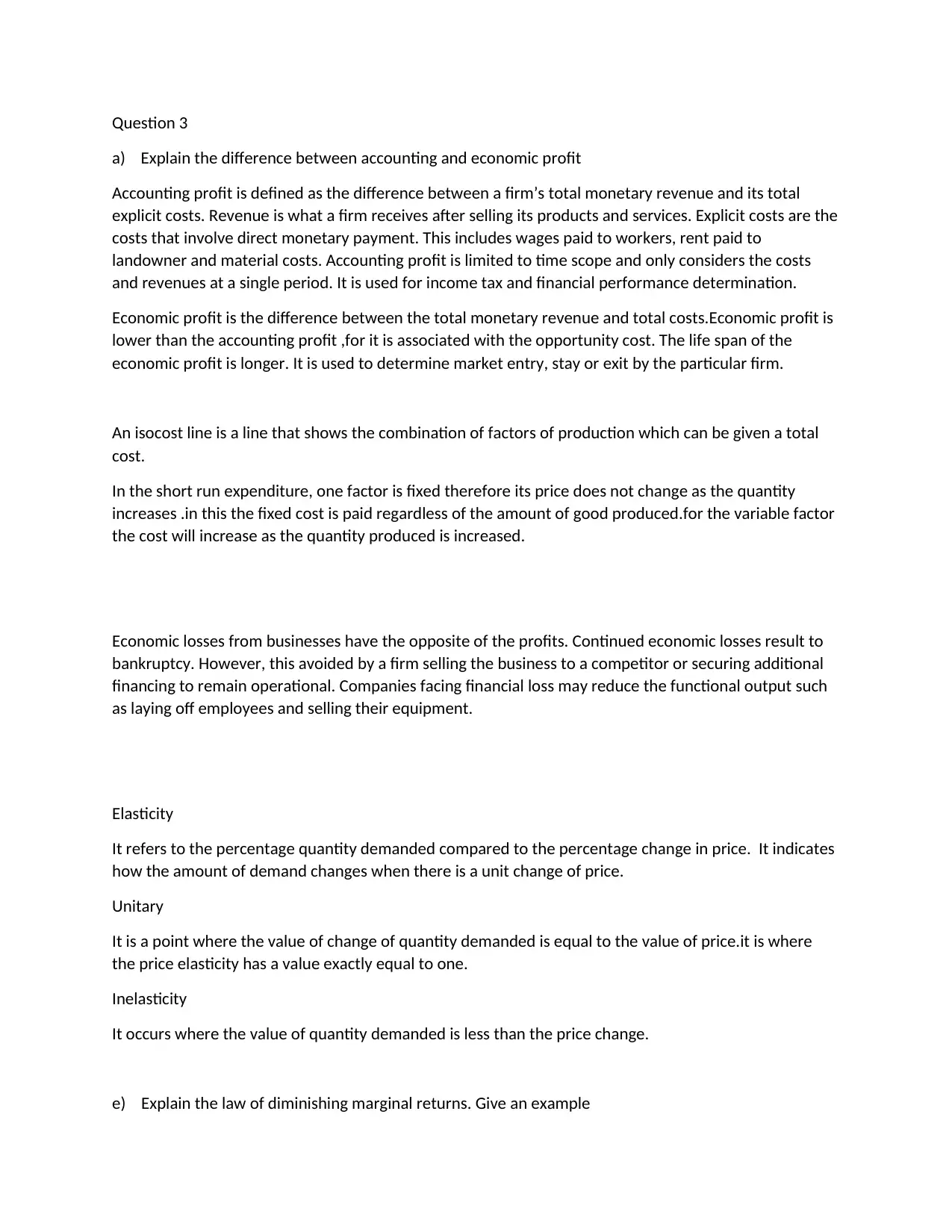
Question 3
a) Explain the difference between accounting and economic profit
Accounting profit is defined as the difference between a firm’s total monetary revenue and its total
explicit costs. Revenue is what a firm receives after selling its products and services. Explicit costs are the
costs that involve direct monetary payment. This includes wages paid to workers, rent paid to
landowner and material costs. Accounting profit is limited to time scope and only considers the costs
and revenues at a single period. It is used for income tax and financial performance determination.
Economic profit is the difference between the total monetary revenue and total costs.Economic profit is
lower than the accounting profit ,for it is associated with the opportunity cost. The life span of the
economic profit is longer. It is used to determine market entry, stay or exit by the particular firm.
An isocost line is a line that shows the combination of factors of production which can be given a total
cost.
In the short run expenditure, one factor is fixed therefore its price does not change as the quantity
increases .in this the fixed cost is paid regardless of the amount of good produced.for the variable factor
the cost will increase as the quantity produced is increased.
Economic losses from businesses have the opposite of the profits. Continued economic losses result to
bankruptcy. However, this avoided by a firm selling the business to a competitor or securing additional
financing to remain operational. Companies facing financial loss may reduce the functional output such
as laying off employees and selling their equipment.
Elasticity
It refers to the percentage quantity demanded compared to the percentage change in price. It indicates
how the amount of demand changes when there is a unit change of price.
Unitary
It is a point where the value of change of quantity demanded is equal to the value of price.it is where
the price elasticity has a value exactly equal to one.
Inelasticity
It occurs where the value of quantity demanded is less than the price change.
e) Explain the law of diminishing marginal returns. Give an example
a) Explain the difference between accounting and economic profit
Accounting profit is defined as the difference between a firm’s total monetary revenue and its total
explicit costs. Revenue is what a firm receives after selling its products and services. Explicit costs are the
costs that involve direct monetary payment. This includes wages paid to workers, rent paid to
landowner and material costs. Accounting profit is limited to time scope and only considers the costs
and revenues at a single period. It is used for income tax and financial performance determination.
Economic profit is the difference between the total monetary revenue and total costs.Economic profit is
lower than the accounting profit ,for it is associated with the opportunity cost. The life span of the
economic profit is longer. It is used to determine market entry, stay or exit by the particular firm.
An isocost line is a line that shows the combination of factors of production which can be given a total
cost.
In the short run expenditure, one factor is fixed therefore its price does not change as the quantity
increases .in this the fixed cost is paid regardless of the amount of good produced.for the variable factor
the cost will increase as the quantity produced is increased.
Economic losses from businesses have the opposite of the profits. Continued economic losses result to
bankruptcy. However, this avoided by a firm selling the business to a competitor or securing additional
financing to remain operational. Companies facing financial loss may reduce the functional output such
as laying off employees and selling their equipment.
Elasticity
It refers to the percentage quantity demanded compared to the percentage change in price. It indicates
how the amount of demand changes when there is a unit change of price.
Unitary
It is a point where the value of change of quantity demanded is equal to the value of price.it is where
the price elasticity has a value exactly equal to one.
Inelasticity
It occurs where the value of quantity demanded is less than the price change.
e) Explain the law of diminishing marginal returns. Give an example
Paraphrase This Document
Need a fresh take? Get an instant paraphrase of this document with our AI Paraphraser

Law of diminishing demands states that as one input factor is increased in a production process, and
holding all other factors constant. With time, the output will start to decrease.
An example is a wheat farmer with three acres of land; he also has a quantity of seeds, fertilizer, water,
and labor. If the farmer has already decided how much seed, fertilizer, and labor he will be using but he
has not decided on how much water to use. As he increases the amount of water, the output of wheat
will arise. With increased the production begins to decrease since too much water can hazardous.
holding all other factors constant. With time, the output will start to decrease.
An example is a wheat farmer with three acres of land; he also has a quantity of seeds, fertilizer, water,
and labor. If the farmer has already decided how much seed, fertilizer, and labor he will be using but he
has not decided on how much water to use. As he increases the amount of water, the output of wheat
will arise. With increased the production begins to decrease since too much water can hazardous.
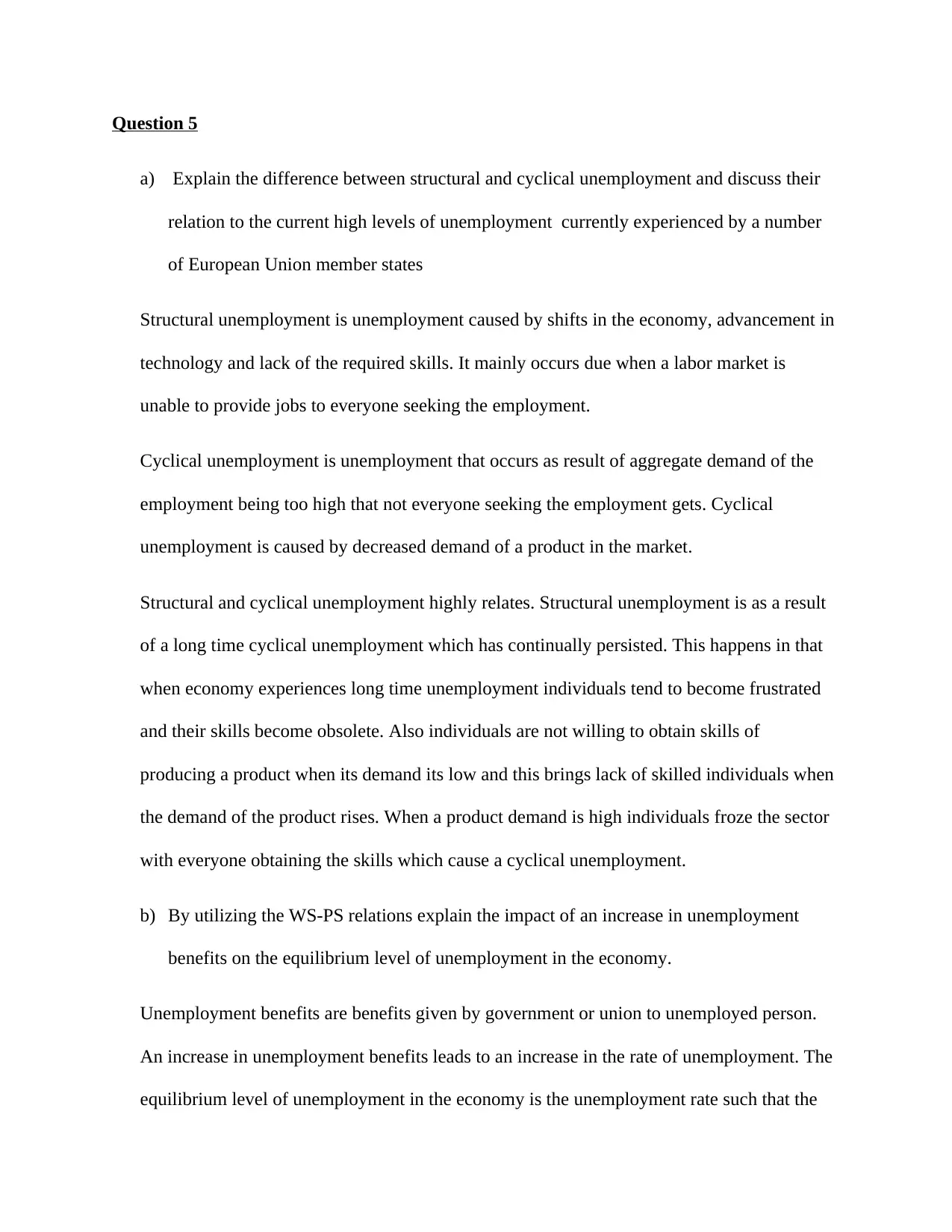
Question 5
a) Explain the difference between structural and cyclical unemployment and discuss their
relation to the current high levels of unemployment currently experienced by a number
of European Union member states
Structural unemployment is unemployment caused by shifts in the economy, advancement in
technology and lack of the required skills. It mainly occurs due when a labor market is
unable to provide jobs to everyone seeking the employment.
Cyclical unemployment is unemployment that occurs as result of aggregate demand of the
employment being too high that not everyone seeking the employment gets. Cyclical
unemployment is caused by decreased demand of a product in the market.
Structural and cyclical unemployment highly relates. Structural unemployment is as a result
of a long time cyclical unemployment which has continually persisted. This happens in that
when economy experiences long time unemployment individuals tend to become frustrated
and their skills become obsolete. Also individuals are not willing to obtain skills of
producing a product when its demand its low and this brings lack of skilled individuals when
the demand of the product rises. When a product demand is high individuals froze the sector
with everyone obtaining the skills which cause a cyclical unemployment.
b) By utilizing the WS-PS relations explain the impact of an increase in unemployment
benefits on the equilibrium level of unemployment in the economy.
Unemployment benefits are benefits given by government or union to unemployed person.
An increase in unemployment benefits leads to an increase in the rate of unemployment. The
equilibrium level of unemployment in the economy is the unemployment rate such that the
a) Explain the difference between structural and cyclical unemployment and discuss their
relation to the current high levels of unemployment currently experienced by a number
of European Union member states
Structural unemployment is unemployment caused by shifts in the economy, advancement in
technology and lack of the required skills. It mainly occurs due when a labor market is
unable to provide jobs to everyone seeking the employment.
Cyclical unemployment is unemployment that occurs as result of aggregate demand of the
employment being too high that not everyone seeking the employment gets. Cyclical
unemployment is caused by decreased demand of a product in the market.
Structural and cyclical unemployment highly relates. Structural unemployment is as a result
of a long time cyclical unemployment which has continually persisted. This happens in that
when economy experiences long time unemployment individuals tend to become frustrated
and their skills become obsolete. Also individuals are not willing to obtain skills of
producing a product when its demand its low and this brings lack of skilled individuals when
the demand of the product rises. When a product demand is high individuals froze the sector
with everyone obtaining the skills which cause a cyclical unemployment.
b) By utilizing the WS-PS relations explain the impact of an increase in unemployment
benefits on the equilibrium level of unemployment in the economy.
Unemployment benefits are benefits given by government or union to unemployed person.
An increase in unemployment benefits leads to an increase in the rate of unemployment. The
equilibrium level of unemployment in the economy is the unemployment rate such that the
⊘ This is a preview!⊘
Do you want full access?
Subscribe today to unlock all pages.

Trusted by 1+ million students worldwide
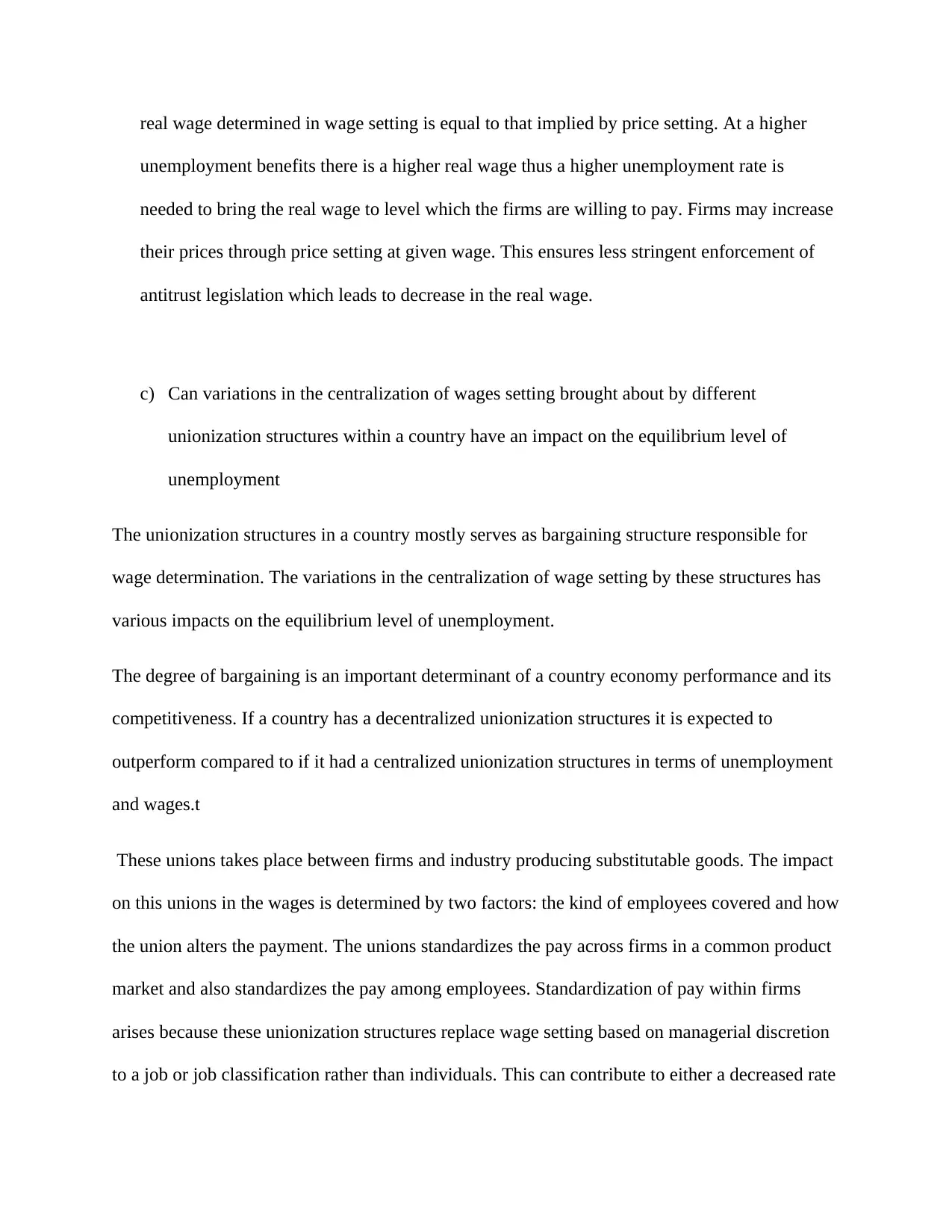
real wage determined in wage setting is equal to that implied by price setting. At a higher
unemployment benefits there is a higher real wage thus a higher unemployment rate is
needed to bring the real wage to level which the firms are willing to pay. Firms may increase
their prices through price setting at given wage. This ensures less stringent enforcement of
antitrust legislation which leads to decrease in the real wage.
c) Can variations in the centralization of wages setting brought about by different
unionization structures within a country have an impact on the equilibrium level of
unemployment
The unionization structures in a country mostly serves as bargaining structure responsible for
wage determination. The variations in the centralization of wage setting by these structures has
various impacts on the equilibrium level of unemployment.
The degree of bargaining is an important determinant of a country economy performance and its
competitiveness. If a country has a decentralized unionization structures it is expected to
outperform compared to if it had a centralized unionization structures in terms of unemployment
and wages.t
These unions takes place between firms and industry producing substitutable goods. The impact
on this unions in the wages is determined by two factors: the kind of employees covered and how
the union alters the payment. The unions standardizes the pay across firms in a common product
market and also standardizes the pay among employees. Standardization of pay within firms
arises because these unionization structures replace wage setting based on managerial discretion
to a job or job classification rather than individuals. This can contribute to either a decreased rate
unemployment benefits there is a higher real wage thus a higher unemployment rate is
needed to bring the real wage to level which the firms are willing to pay. Firms may increase
their prices through price setting at given wage. This ensures less stringent enforcement of
antitrust legislation which leads to decrease in the real wage.
c) Can variations in the centralization of wages setting brought about by different
unionization structures within a country have an impact on the equilibrium level of
unemployment
The unionization structures in a country mostly serves as bargaining structure responsible for
wage determination. The variations in the centralization of wage setting by these structures has
various impacts on the equilibrium level of unemployment.
The degree of bargaining is an important determinant of a country economy performance and its
competitiveness. If a country has a decentralized unionization structures it is expected to
outperform compared to if it had a centralized unionization structures in terms of unemployment
and wages.t
These unions takes place between firms and industry producing substitutable goods. The impact
on this unions in the wages is determined by two factors: the kind of employees covered and how
the union alters the payment. The unions standardizes the pay across firms in a common product
market and also standardizes the pay among employees. Standardization of pay within firms
arises because these unionization structures replace wage setting based on managerial discretion
to a job or job classification rather than individuals. This can contribute to either a decreased rate
Paraphrase This Document
Need a fresh take? Get an instant paraphrase of this document with our AI Paraphraser
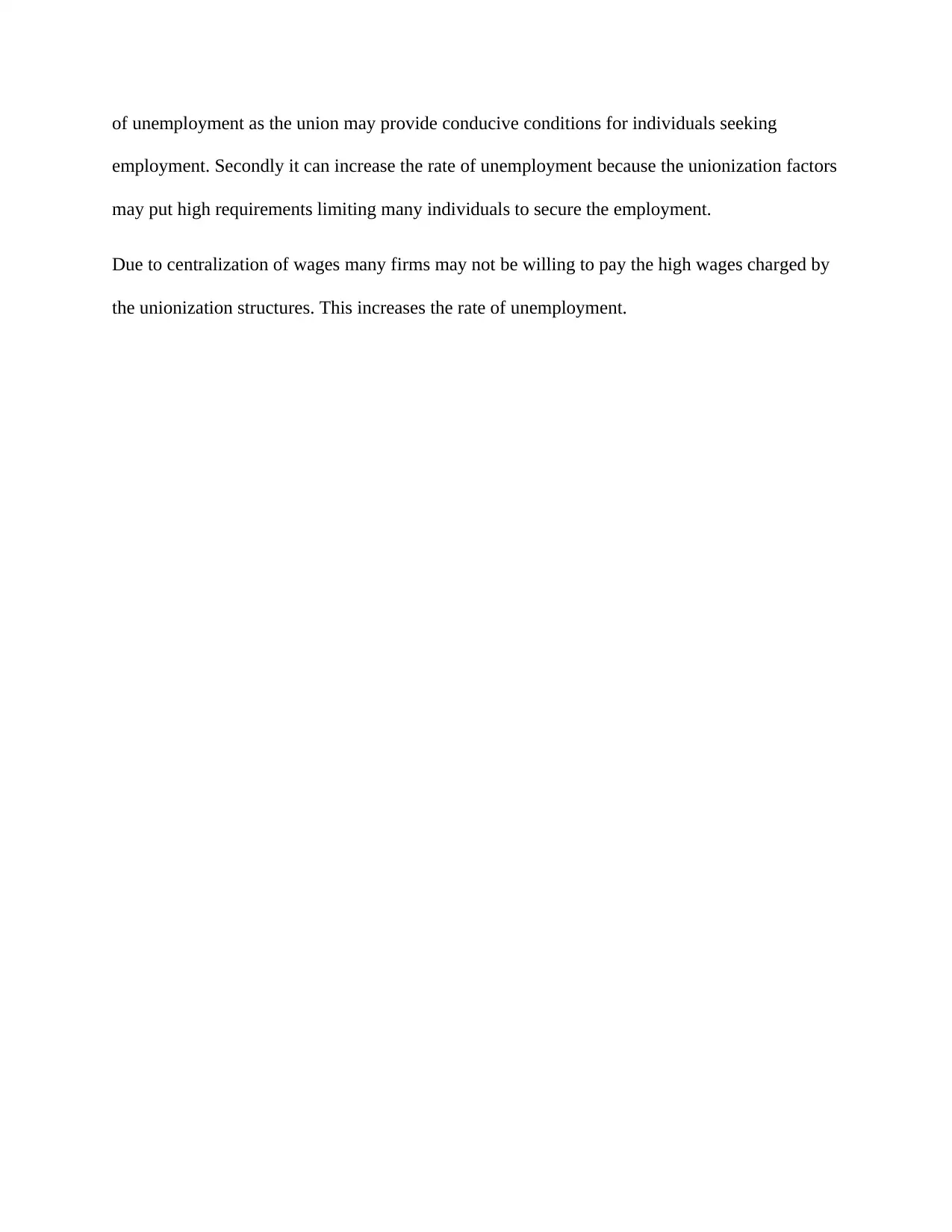
of unemployment as the union may provide conducive conditions for individuals seeking
employment. Secondly it can increase the rate of unemployment because the unionization factors
may put high requirements limiting many individuals to secure the employment.
Due to centralization of wages many firms may not be willing to pay the high wages charged by
the unionization structures. This increases the rate of unemployment.
employment. Secondly it can increase the rate of unemployment because the unionization factors
may put high requirements limiting many individuals to secure the employment.
Due to centralization of wages many firms may not be willing to pay the high wages charged by
the unionization structures. This increases the rate of unemployment.
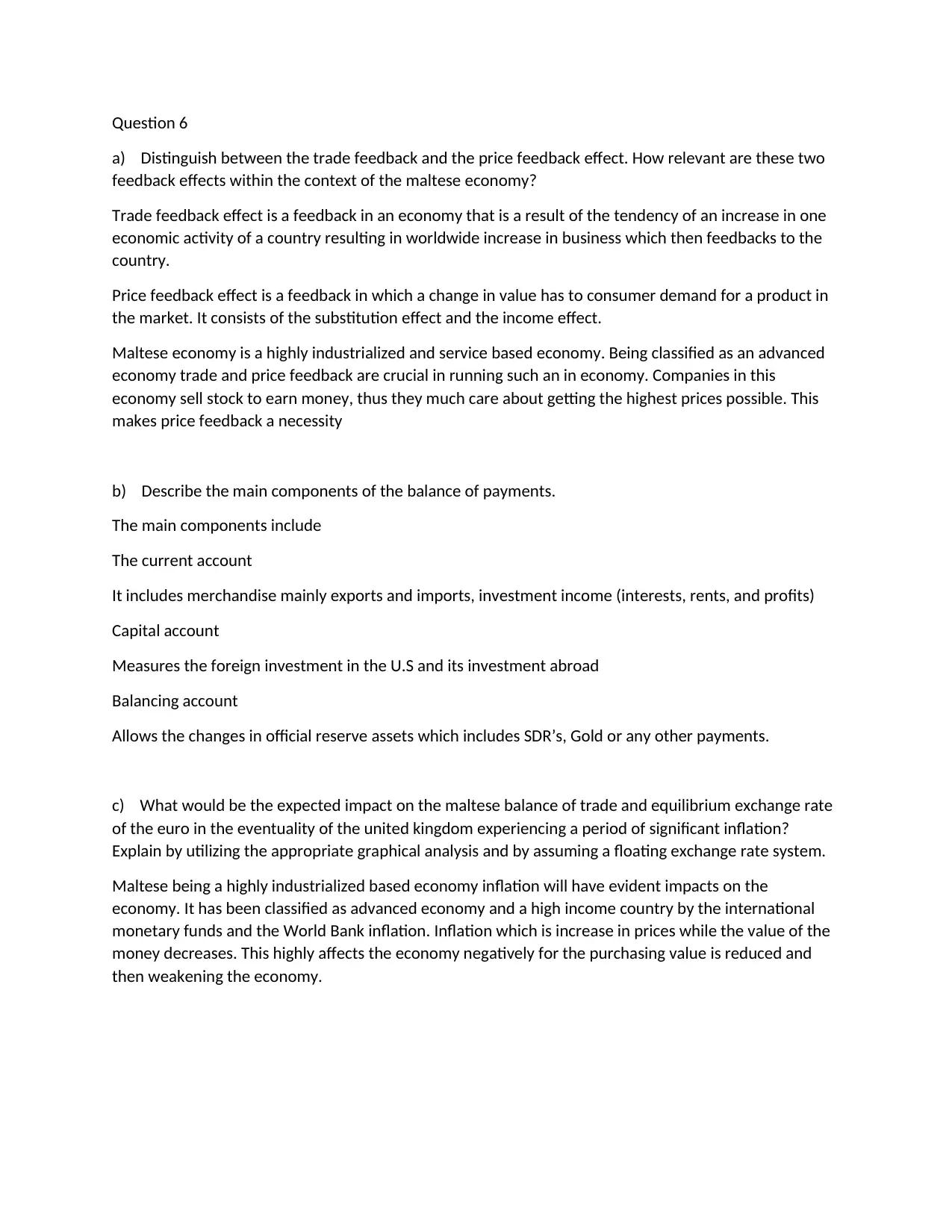
Question 6
a) Distinguish between the trade feedback and the price feedback effect. How relevant are these two
feedback effects within the context of the maltese economy?
Trade feedback effect is a feedback in an economy that is a result of the tendency of an increase in one
economic activity of a country resulting in worldwide increase in business which then feedbacks to the
country.
Price feedback effect is a feedback in which a change in value has to consumer demand for a product in
the market. It consists of the substitution effect and the income effect.
Maltese economy is a highly industrialized and service based economy. Being classified as an advanced
economy trade and price feedback are crucial in running such an in economy. Companies in this
economy sell stock to earn money, thus they much care about getting the highest prices possible. This
makes price feedback a necessity
b) Describe the main components of the balance of payments.
The main components include
The current account
It includes merchandise mainly exports and imports, investment income (interests, rents, and profits)
Capital account
Measures the foreign investment in the U.S and its investment abroad
Balancing account
Allows the changes in official reserve assets which includes SDR’s, Gold or any other payments.
c) What would be the expected impact on the maltese balance of trade and equilibrium exchange rate
of the euro in the eventuality of the united kingdom experiencing a period of significant inflation?
Explain by utilizing the appropriate graphical analysis and by assuming a floating exchange rate system.
Maltese being a highly industrialized based economy inflation will have evident impacts on the
economy. It has been classified as advanced economy and a high income country by the international
monetary funds and the World Bank inflation. Inflation which is increase in prices while the value of the
money decreases. This highly affects the economy negatively for the purchasing value is reduced and
then weakening the economy.
a) Distinguish between the trade feedback and the price feedback effect. How relevant are these two
feedback effects within the context of the maltese economy?
Trade feedback effect is a feedback in an economy that is a result of the tendency of an increase in one
economic activity of a country resulting in worldwide increase in business which then feedbacks to the
country.
Price feedback effect is a feedback in which a change in value has to consumer demand for a product in
the market. It consists of the substitution effect and the income effect.
Maltese economy is a highly industrialized and service based economy. Being classified as an advanced
economy trade and price feedback are crucial in running such an in economy. Companies in this
economy sell stock to earn money, thus they much care about getting the highest prices possible. This
makes price feedback a necessity
b) Describe the main components of the balance of payments.
The main components include
The current account
It includes merchandise mainly exports and imports, investment income (interests, rents, and profits)
Capital account
Measures the foreign investment in the U.S and its investment abroad
Balancing account
Allows the changes in official reserve assets which includes SDR’s, Gold or any other payments.
c) What would be the expected impact on the maltese balance of trade and equilibrium exchange rate
of the euro in the eventuality of the united kingdom experiencing a period of significant inflation?
Explain by utilizing the appropriate graphical analysis and by assuming a floating exchange rate system.
Maltese being a highly industrialized based economy inflation will have evident impacts on the
economy. It has been classified as advanced economy and a high income country by the international
monetary funds and the World Bank inflation. Inflation which is increase in prices while the value of the
money decreases. This highly affects the economy negatively for the purchasing value is reduced and
then weakening the economy.
⊘ This is a preview!⊘
Do you want full access?
Subscribe today to unlock all pages.

Trusted by 1+ million students worldwide

1 out of 7
Related Documents
Your All-in-One AI-Powered Toolkit for Academic Success.
+13062052269
info@desklib.com
Available 24*7 on WhatsApp / Email
![[object Object]](/_next/static/media/star-bottom.7253800d.svg)
Unlock your academic potential
Copyright © 2020–2026 A2Z Services. All Rights Reserved. Developed and managed by ZUCOL.



